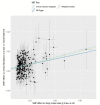Body Mass Index and the Risk of Atrial Fibrillation: A Mendelian Randomization Study
- PMID: 35565843
- PMCID: PMC9101688
- DOI: 10.3390/nu14091878
Body Mass Index and the Risk of Atrial Fibrillation: A Mendelian Randomization Study
Abstract
Although observational studies have shown positive associations between body mass index (BMI) and the risk of atrial fibrillation (AF), the causal relationship is still uncertain owing to the susceptibility to confounding and reverse causation. This study aimed to examine the potential causality of BMI on AF by conducting a two-sample Mendelian randomization (TSMR) study.
Methods: The independent genetic variants associated with BMI (n = 303) at the genome-wide significant level were derived as instrumental variables (IV) from the Genetic Investigation of Anthropometric Traits (GIANT) consortium consisting of 681,275 individuals of European ancestry. We then derived the outcome data from a GWAS meta-analysis comprised of 60,620 cases and 970,216 controls of European ancestry. The TSMR analyses were performed in five methods, namely inverse variance weighted (IVW) method, MR-Egger regression, the weighted median estimator (WME), the generalized summary data-based Mendelian randomization (GSMR), and the robust adjusted profile score (RAPS), to investigate whether BMI was causally associated with the risk of AF.
Results: We found a genetically determined 1-standard deviation (SD) increment of BMI causally increased a 42.5% risk of AF (OR = 1.425; 95% CI, 1.346 to 1.509) based on the IVW method, which was consistent with the results of MR-Egger regression, WME, GSMR, as well as RAPS. The Mendelian randomization assumptions did not seem to be violated.
Conclusion: This study provides evidence that higher BMI causally increased the risk of AF, suggesting control of BMI and obesity for prevention of AF.
Keywords: BMI; Mendelian randomization; atrial fibrillation; causal inference.
Conflict of interest statement
The authors declare no conflict of interest.
Figures



Similar articles
-
Exploring the causal association of rheumatoid arthritis with atrial fibrillation: a Mendelian randomization study.Clin Rheumatol. 2024 Jan;43(1):29-40. doi: 10.1007/s10067-023-06804-4. Epub 2023 Nov 6. Clin Rheumatol. 2024. PMID: 37930596
-
The Risk of Atrial Fibrillation Increases with Earlier Onset of Obesity: A Mendelian Randomization Study.Int J Med Sci. 2022 Aug 8;19(9):1388-1398. doi: 10.7150/ijms.72334. eCollection 2022. Int J Med Sci. 2022. PMID: 36035367 Free PMC article.
-
Heart rate variability and atrial fibrillation in the general population: a longitudinal and Mendelian randomization study.Clin Res Cardiol. 2023 Jun;112(6):747-758. doi: 10.1007/s00392-022-02072-5. Epub 2022 Aug 13. Clin Res Cardiol. 2023. PMID: 35962833 Free PMC article.
-
Meta-analysis and Mendelian randomization: A review.Res Synth Methods. 2019 Dec;10(4):486-496. doi: 10.1002/jrsm.1346. Epub 2019 Apr 23. Res Synth Methods. 2019. PMID: 30861319 Free PMC article. Review.
-
Causal inference in the field of arrhythmia: An introduction to mendelian randomization.Heart Rhythm. 2025 Jan;22(1):203-216. doi: 10.1016/j.hrthm.2024.07.015. Epub 2024 Jul 15. Heart Rhythm. 2025. PMID: 39019383 Review.
Cited by
-
Causal relationship between atrial fibrillation and leukocyte telomere length: A two sample, bidirectional Mendelian randomization study.Front Cardiovasc Med. 2023 Feb 15;10:1093255. doi: 10.3389/fcvm.2023.1093255. eCollection 2023. Front Cardiovasc Med. 2023. PMID: 36873417 Free PMC article.
-
Analysis of risk factors and short-term prognostic factors of arrhythmia in patients infected with mild/moderate SARS-CoV-2 Omicron variant.Front Med (Lausanne). 2023 Jul 27;10:1186200. doi: 10.3389/fmed.2023.1186200. eCollection 2023. Front Med (Lausanne). 2023. PMID: 37575983 Free PMC article.
-
Association between gut microbiota and diabetic nephropathy: a mendelian randomization study.Front Microbiol. 2024 Mar 27;15:1309871. doi: 10.3389/fmicb.2024.1309871. eCollection 2024. Front Microbiol. 2024. PMID: 38601939 Free PMC article.
-
Large-scale genome-wide association studies reveal the genetic causal etiology between air pollutants and autoimmune diseases.J Transl Med. 2024 Apr 29;22(1):392. doi: 10.1186/s12967-024-04928-y. J Transl Med. 2024. PMID: 38685026 Free PMC article.
-
The Impact of Weight Categories on the Association Between Atrial Fibrillation/Flutter and Known Risk Factors: A Nationwide Inpatient Data Analysis.J Clin Med. 2025 Mar 23;14(7):2187. doi: 10.3390/jcm14072187. J Clin Med. 2025. PMID: 40217639 Free PMC article.
References
-
- Benjamin E.J., Muntner P., Alonso A., Bittencourt M.S., Callaway C.W., Carson A.P., Chamberlain A.M., Chang A.R., Cheng S., Das S.R., et al. Heart Disease and Stroke Statistics-2019 Update: A Report From the American Heart Association. Circulation. 2019;139:e56–e528. doi: 10.1161/CIR.0000000000000659. - DOI - PubMed
-
- Hindricks G., Potpara T., Dagres N., Arbelo E., Bax J.J., Blomstrom-Lundqvist C., Boriani G., Castella M., Dan G.A., Dilaveris P.E., et al. 2020 ESC Guidelines for the diagnosis and management of atrial fibrillation developed in collaboration with the European Association for Cardio-Thoracic Surgery (EACTS): The Task Force for the diagnosis and management of atrial fibrillation of the European Society of Cardiology (ESC) Developed with the special contribution of the European Heart Rhythm Association (EHRA) of the ESC. Eur. Heart J. 2021;42:373–498. doi: 10.1093/eurheartj/ehaa612. - DOI - PubMed
-
- Schnabel R.B., Yin X., Gona P., Larson M.G., Beiser A.S., McManus D.D., Newton-Cheh C., Lubitz S.A., Magnani J.W., Ellinor P.T., et al. 50 year trends in atrial fibrillation prevalence, incidence, risk factors, and mortality in the Framingham Heart Study: A cohort study. Lancet. 2015;386:154–162. doi: 10.1016/S0140-6736(14)61774-8. - DOI - PMC - PubMed
-
- Krijthe B.P., Kunst A., Benjamin E.J., Lip G.Y., Franco O.H., Hofman A., Witteman J.C., Stricker B.H., Heeringa J. Projections on the number of individuals with atrial fibrillation in the European Union, from 2000 to 2060. Eur. Heart J. 2013;34:2746–2751. doi: 10.1093/eurheartj/eht280. - DOI - PMC - PubMed
Publication types
MeSH terms
LinkOut - more resources
Full Text Sources
Medical

